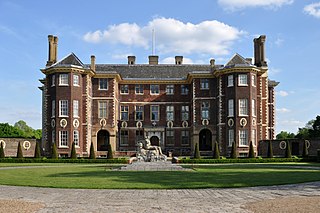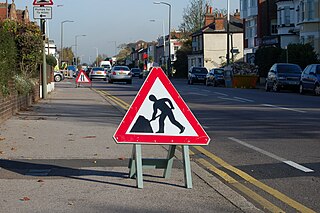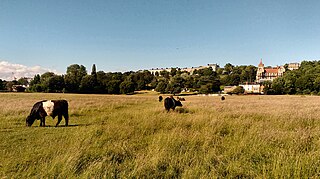Richmond is a town in south-west London, 8.2 miles (13.2 km) west-southwest of Charing Cross. It stands on the River Thames, and features many parks and open spaces, including Richmond Park, and many protected conservation areas, which include much of Richmond Hill. A specific Act of Parliament protects the scenic view of the River Thames from Richmond.

The London County Council (LCC) was the principal local government body for the County of London throughout its existence from 1889 to 1965, and the first London-wide general municipal authority to be directly elected. It covered the area today known as Inner London and was replaced by the Greater London Council. The LCC was the largest, most significant and most ambitious English municipal authority of its day.

Richmond Park is a constituency in Greater London represented in the House of Commons of the UK Parliament. Since 2019, its Member of Parliament (MP) has been Sarah Olney of the Liberal Democrats.

Ham is a suburban district in Richmond, south-west London. It has meadows adjoining the River Thames where the Thames Path National Trail also runs. Most of Ham is in the London Borough of Richmond upon Thames and, chiefly, within the ward of Ham, Petersham and Richmond Riverside; the rest is in the Royal Borough of Kingston upon Thames. The district has modest convenience shops and amenities, including a petrol station and several pubs, but its commerce is subsidiary to the nearby regional-level economic centre of Kingston upon Thames.

The Abortion Act 1967 is an act of the Parliament of the United Kingdom that legalised abortion in Great Britain on certain grounds by registered practitioners, and regulated the tax-paid provision of such medical practices through the National Health Service (NHS).

The London Government Act 1963 is an act of the Parliament of the United Kingdom, which created Greater London and a new local government structure within it. The Act significantly reduced the number of local government districts in the area, resulting in local authorities responsible for larger areas and populations. The upper tier of local government was reformed to cover the whole of the Greater London area and with a more strategic role; and the split of functions between upper and lower tiers was recast. The Act classified the boroughs into inner and outer London groups. The City of London and its corporation were essentially unreformed by the legislation. Subsequent amendments to the Act have significantly amended the upper tier arrangements, with the Greater London Council abolished in 1986, and the Greater London Authority introduced in 2000. As of 2016, the London boroughs are more or less identical to those created in 1965, although with some enhanced powers over services such as waste management and education.

The Sexual Offences Act 1967 is an act of Parliament in the United Kingdom. It legalised homosexual acts in England and Wales, on the condition that they were consensual, in private and between two men who had attained the age of 21. The law was extended to Scotland by the Criminal Justice (Scotland) Act 1980 and to Northern Ireland by the Homosexual Offences Order 1982.
Richmond and Barnes was a parliamentary constituency in the London Borough of Richmond upon Thames, a south-western suburb of the capital. It returned one Member of Parliament (MP) to the House of Commons of the Parliament of the United Kingdom. The constituency was created in 1983 and abolished in 1997.

The A307 road runs 13.2 miles (21.2 km) through SW London and NW Surrey. It is primary at the north-east end; the remainder is non-primary, generally superseded in the mid-twentieth century in two stages by newer alignments of the Portsmouth Road, the Kingston bypass and Esher bypass of the A3, which runs along a slightly oblique axis.

Richmond Hill in Richmond, London, is a hill that begins gently in its townside through the former fields, orchards and vineyard to a point just within Richmond Park, the deer park emparked and enclosed by Charles I.
Richmond (1918–1983) was a parliamentary constituency centred on the town of Richmond. The seat mirrored for its first 47 years a small northern projection of Surrey. For the final 18 years its area, in local government, fell into the new county of Greater London.

Hammerton's Ferry is a pedestrian and cycle ferry service across the River Thames in the London Borough of Richmond upon Thames, London, England. The ferry links the river's northern bank near Marble Hill House in Twickenham with its southern bank near Ham House in Ham. It is one of only four remaining ferry routes in London not to be replaced by a bridge or tunnel.
William John Manners Tollemache, 9th Earl of Dysart DL in the Peerage of Scotland, was also a Baronet (cr.1793) in the Baronetage of Great Britain, Lord Lieutenant of Rutland (1881–1906), and Justice of the Peace for Leicestershire and Lincolnshire.

An Act of Parliament in the United Kingdom is primary legislation passed by the UK Parliament in Westminster, London.
The federation of Stoke-on-Trent was the 1910 amalgamation of the six Staffordshire Potteries towns of Burslem, Tunstall, Stoke-upon-Trent, Hanley, Fenton and Longton into the single county borough of Stoke-on-Trent. The federation was one of the largest mergers of local authorities, involving the greatest number of previously separate urban authorities, to take place in England between the nineteenth century and the 1960s. The 1910 federation was the culmination of a process of urban growth and municipal change that started in the early 19th century.
The Petersham Hole was a sink hole caused by subsidence of a sewer which forced the total closure of the A307 road in Petersham in the London Borough of Richmond upon Thames in 1979–80. It caused long-term disruption to traffic in the surrounding area and significant direct and indirect costs.

Sudbrook and its tributary, the Latchmere stream, are north-flowing streams in London, England, that drain northern Kingston upon Thames and the eastern extreme of Ham following a meander scar in a terrace; the upper part of the Sudbrook drains a narrow vale in Richmond Park's southern corner into the tidal Thames.

Ham Common is an area of common land in Ham, London. It is a conservation area in, and managed by, the London Borough of Richmond upon Thames. It comprises 48.69 hectares, the second largest area of common land in the borough, 2 acres (0.81 ha) smaller than Barnes Common. It is divided into two distinct habitats, grassland and woodland, separated by the A307, Upper Ham Road. It is an area of ecological, historical and recreational interest, designated a Local Nature Reserve.

Petersham Meadows are a 24-acre water-meadow that lie alongside the River Thames in Petersham, London, bounded by Buccleuch Gardens, Manor Farm Livery Stables, the main Petersham Road (A307) and River Lane. The Capital Ring footpath crosses the meadow to reach Petersham and the Thames Path follows the towpath.
Sir Charles Burt a solicitor and local politician in Richmond, Surrey. He was elected to the first Surrey County Council in 1889 and was Mayor of Richmond in 1892–93. He campaigned for the preservation of several important local open spaces, assisting in the purchase of Marble Hill House and in protecting the view from Richmond Hill.














